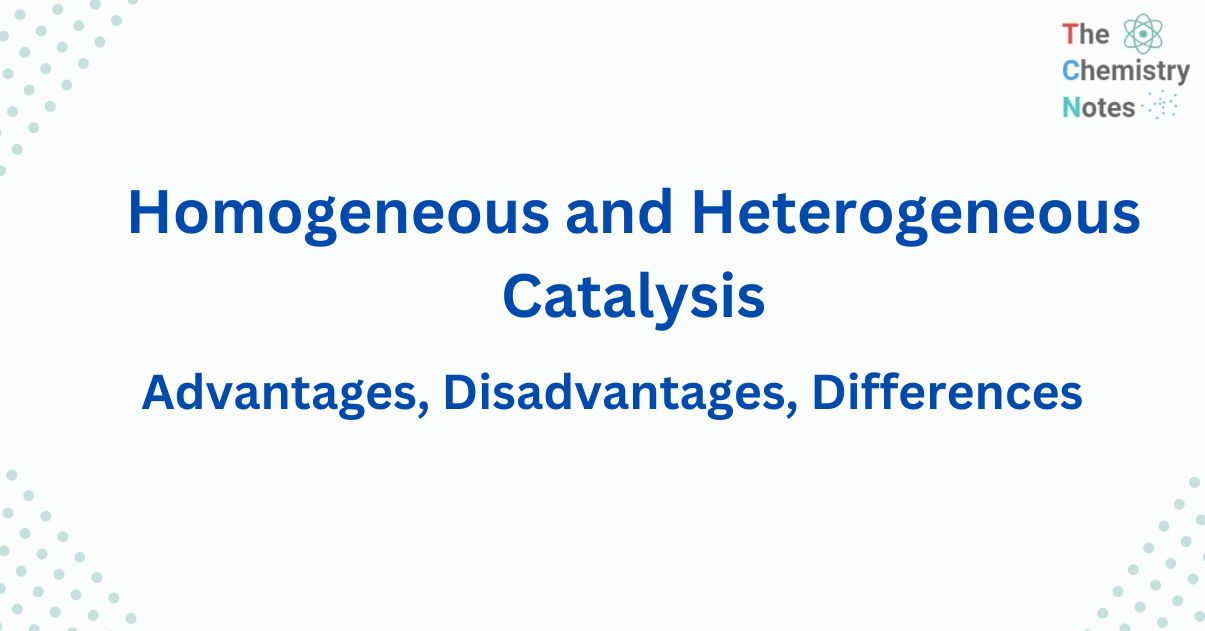
Homogeneous and Heterogeneous Catalysis are catalytic processes, classified on the basis of the nature of the phase. In homogenous catalysis reactants and catalysts are in the same phase while in heterogenous catalysis they appear in different phases.
Homogeneous catalysis
Homogeneous catalysis occurs when the reactants and the catalyst are in the same phase. For example: in the lead chamber process, sulfur dioxide is oxidized to sulfur trioxide with dioxygen in the presence of nitrogen oxides as the catalyst. All of the reactants, sulfur dioxide and oxygen, as well as the catalyst, nitric oxide, are in the same phase.
2SO2 (g) + O2(g) → 2SO3 (g) (in the presence of gaseous NO)
Based on his idea of acids and bases, the Danish physical chemist J.N. Bronsted presented a generalized treatment of homogeneous catalysis by acids and bases in the mid-1920s. An acid, according to Bronsted, is a molecule that can supply a proton, whereas a base is a molecule that can absorb a proton.
According to this assumption, the range of acids includes bisulfate ion (HSO4–) acetic acid ( CH3COOH), water ( H2O), hydronium ion( H3O+), and ammonium ion (NH4+). Sulfate ion (SO42- ), acetate ion (CH3COO–), hydroxide ion (OH–), water (H2O), and ammonia, NH3 are the equivalent bases. Examples include the acid-base catalysis of glucose conversion (mutarotation) to a closely similar form.
Homogeneous catalysis frequently involves redox processes in which the ions involved in catalysis change oxidation numbers.
Because transition metal ions may change oxidation numbers, they are frequently used as catalysts. Homogeneous catalysts are utilized in the first stage and then reformed in the second.
For example:
This is a slow reaction in which peroxy disulfate (S2 O82- ) ions oxidize iodide to iodine. The reaction is as follows:
S2O82- (aq) + 2I– (aq) → 2SO42- (aq) + I2 (aq)
Because both the S2O82- and I– ions have a negative charge, the ions will need a lot of energy to overcome the repulsive forces and collision with one other. As a result, Fe3+ (aq) ions are employed as a homogeneous catalyst. Two redox processes are involved in the catalysis. The reaction involves:
- Firstly, I– reduces Fe3+ ions to Fe2+.
2Fe3+ (aq) + 2I– (aq) → 2Fe2+ (aq) + I2 (aq)
- Then, Fe2+ is oxidized into Fe3+ by S2O82-
2Fe2+ (aq) + S2O82- (aq) → 2Fe3+ (aq) + 2SO42- (aq)
There are no repulsive forces when combining the reactants with a positively charged Fe ion, and the activation energy is greatly reduced. It makes no difference which reaction comes first. So, Fe2+ can be first oxidized to Fe3+ followed by the reduction of Fe3+ to Fe2+.
Advantage of homogeneous catalysis
Because both the catalyst and the reactant molecules are in the same phase (as opposed to heterogeneous catalysis), there is a high degree of contact between them.
Disadvantage of homogeneous catalysis
One drawback is that after the reaction is completed, the homogeneous catalyst is frequently irreversible. As a result, adopting homogeneous catalysis for industrial-scale production processes may not be as efficient or economically viable.
Heterogeneous catalysis
The catalyst and the reactants are in different phases in heterogeneous catalysis. The catalyst is usually solid, but the reactant can be either gaseous or liquid.
To catalyze the reactions of gaseous or liquid reactants, solid metals, and metal oxides are commonly utilized. Solid catalysts frequently serve as a surface for reactions to occur, where one or more reactants will adsorb (bond to the surface). Molecules react at the surface of a solid catalyst in heterogeneous catalysis. A heterogeneous catalyst’s mode of action consists of the following steps:
Reactant adsorption (or chemisorption) on the catalyst surface
- The reactants diffuse to the catalyst’s surface.
- Weak forces physically adsorb the reactant onto the surface.
- Stronger bonds chemically adsorb the reactant to the surface.
- Chemisorption weakens the bonds between the reactant atoms.
Desorption of the products
The bonds between the products and the catalyst disintegrate to the point where the products separate from the surface.
For example: Iron is used in the Haber process.
The Haber process generates ammonia (NH3) from nitrogen (N2) and hydrogen (H2). The reaction can be accelerated by using an iron catalyst, which brings the reactants close together on the metal surface. This raises the possibility of their interacting with one another. The iron catalyst works in the following way:
First, nitrogen and hydrogen gas get diffused to the iron surface. Adsorption of reactant molecules onto the iron surface through the formation of bonds between the iron and reactant atoms. These connections are so strong that they weaken the covalent interactions between nitrogen and hydrogen atoms in N2 and H2. They are, however, weak enough to break once the catalysis is complete.
The reaction occurs between adsorbed nitrogen and hydrogen atoms, which react on the iron surface to generate NH3. When the bonds between the NH3 and the iron surface weaken and eventually break, desorption occurs. The NH3 that is generated diffuses away from the iron surface.
Advantages of heterogeneous catalysis
One of the primary advantages of utilizing a heterogeneous catalyst is that it may be easily separated from a reaction mixture, for example, through filtration. As a result, costly catalysts can be readily and successfully recovered, which is an important concern, particularly for industrial-scale manufacturing operations.
Disadvantages of heterogeneous catalysis
The availability of surface area on the catalyst is a restriction of heterogeneous catalysis. When the surface of the catalyst is entirely saturated with reactant molecules (i.e. no more reactants can fit on the surface), the reaction cycle cannot continue until some of the product molecules leave the surface, providing some space for new reactant molecules to form. As a result, the adsorption stage in a heterogeneously catalyzed process is frequently the rate-limiting step.
Difference between homogeneous and heterogeneous Catalysis
Operating temperature
The operating temperature for homogeneous catalysis is relatively low temperatures. The presence of a solvent, which is required to dissolve the catalyst, may reduce the temperature of the reaction, but it also demands the use of mild conditions. The usage of high pressures is an exception. In such instances, the reaction temperature is restricted by the stability of the homogeneous catalyst, which is known to be fairly limited. However, in heterogeneous catalysis, the only constraint is the catalyst’s stability under severe conditions.
Diffusivity
In homogeneous catalysis, there is high diffusivity when homogeneous. Under adequate stirring, having all reactants and catalysts in one phase greatly increases diffusivity.
Diffusivity may be an issue for heterogeneous catalysts with minimal surface area.
Heat Transmission
In homogeneous catalysis, there is excellent heat transfer, having all of the reactants and catalysts in the same phase. Because of the differing heat capacities of the reactants and catalyst, heat transfer can be a problem during heterogeneous catalysis.
Catalyst separation
In homogeneous catalysis, the separation of the products from the catalyst is normally expensive, except for biphasic catalysis, while, in heterogeneous catalysis, the separation of the products from the catalyst is usually simple.
Active site
In homogeneous systems active sites are well-defined in most cases. Catalysts are typically single-atom transition metals that are stabilized by ligands.
In heterogeneous systems, there is generally an undefined active site. When working with metal particles on a support, the active site may consist of only a few percent of the metal (often small particles), and various zones of the same particle may have distinct catalytic capabilities.
Catalyst modification
Catalyst modification in homogeneous catalysis is comparatively simple. By changing the donor atoms in the ligands or adjusting the ligands’ capacity to donate, one can adjust the electronic and steric characteristics of the metal. If triphenylphosphine is the ligand and a less donating phosphine is required, the phenyl groups on the phosphine could be modified (by adding CF3, F, and other electron-withdrawing groups).
There are several synthetic methods accessible, all of which depend on fundamental concepts developed in organic and organometallic chemistry.
In the case of heterogeneous catalysis quite challenging. Controlling particle size and, more broadly, the active site at the molecular level is extremely difficult. There are few synthetic approaches available.
References
- http://www.nanoer.net/d/img/fundamental%20concepts%20in%20heterogeneous%20catalysis-Jens_K._Nrskov,_Felix_Studt,_Frank_Abild-Pederse.pdf.
- https://byjus.com/chemistry/catalysis/
- https://www.britannica.com/science/catalysis.
- https://chem.libretexts.org/Bookshelves/General_Chemistry/Interactive_Chemistry_(Moore_Zhou_and_Garand)/03%3A_Unit_Three/3.08%3A_Day_25-_Homogeneous_and_Heterogeneous_Catalysis
- https://www.eolss.net/sample-chapters/c06/e6-100-10-00.pdf
- https://uen.pressbooks.pub/introductorychemistry/chapter/catalysis/#:~:text=Homogeneous%20catalysts%20are%20those%20which,in%20a%20liquid%20reaction%20mixture.
- https://www.chemguide.co.uk/physical/catalysis/introduction.html.
- https://www.britannica.com/science/catalysis/Classification-of-catalysts
